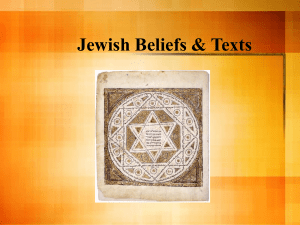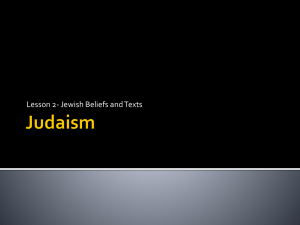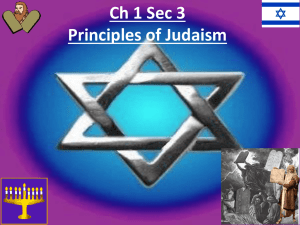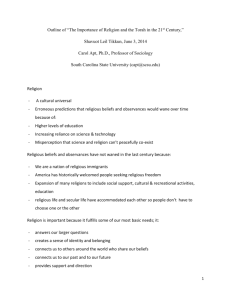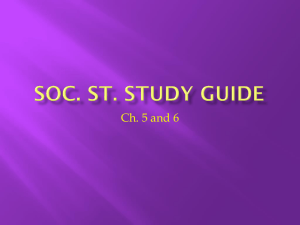10.1 - The Three Monotheistic Religions
advertisement
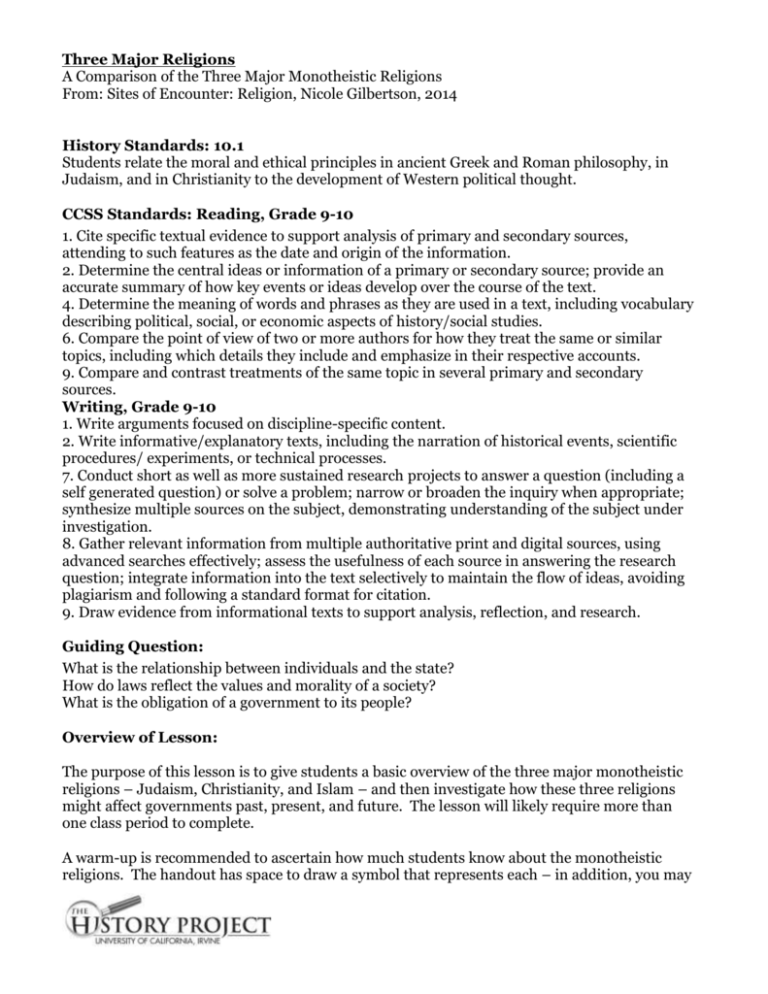
Three Major Religions A Comparison of the Three Major Monotheistic Religions From: Sites of Encounter: Religion, Nicole Gilbertson, 2014 History Standards: 10.1 Students relate the moral and ethical principles in ancient Greek and Roman philosophy, in Judaism, and in Christianity to the development of Western political thought. CCSS Standards: Reading, Grade 9-10 1. Cite specific textual evidence to support analysis of primary and secondary sources, attending to such features as the date and origin of the information. 2. Determine the central ideas or information of a primary or secondary source; provide an accurate summary of how key events or ideas develop over the course of the text. 4. Determine the meaning of words and phrases as they are used in a text, including vocabulary describing political, social, or economic aspects of history/social studies. 6. Compare the point of view of two or more authors for how they treat the same or similar topics, including which details they include and emphasize in their respective accounts. 9. Compare and contrast treatments of the same topic in several primary and secondary sources. Writing, Grade 9-10 1. Write arguments focused on discipline-specific content. 2. Write informative/explanatory texts, including the narration of historical events, scientific procedures/ experiments, or technical processes. 7. Conduct short as well as more sustained research projects to answer a question (including a self generated question) or solve a problem; narrow or broaden the inquiry when appropriate; synthesize multiple sources on the subject, demonstrating understanding of the subject under investigation. 8. Gather relevant information from multiple authoritative print and digital sources, using advanced searches effectively; assess the usefulness of each source in answering the research question; integrate information into the text selectively to maintain the flow of ideas, avoiding plagiarism and following a standard format for citation. 9. Draw evidence from informational texts to support analysis, reflection, and research. Guiding Question: What is the relationship between individuals and the state? How do laws reflect the values and morality of a society? What is the obligation of a government to its people? Overview of Lesson: The purpose of this lesson is to give students a basic overview of the three major monotheistic religions – Judaism, Christianity, and Islam – and then investigate how these three religions might affect governments past, present, and future. The lesson will likely require more than one class period to complete. A warm-up is recommended to ascertain how much students know about the monotheistic religions. The handout has space to draw a symbol that represents each – in addition, you may have students write or discuss the history, beliefs, or holy books that are connected to each religion. A quick whole class discussion should ensure that all students are on the same page. The handout that follows contains text-dependent questions for the three short readings (which are included at the very end of this lesson). Depending on the level of your students, it may be helpful to read the first article aloud and have students answer these questions as you go, allowing you to model think-alouds and ask more probing questions. If students struggle, you may repeat this format with the remaining readings – if not, they may complete them in small groups, partnerships, or individually. Students should then attempt to answer the wrapup questions by themselves with as many details as they can muster, before sharing their answers with an elbow partner. If time allows, ask the class to volunteer a few answers aloud. This is likely to be a stopping point. Once class re-convenes, ask students how they think these religions might affect government. Have them brainstorm ways that this might occur. Remind them that there are good and bad effects from the confluence of religion and politics. Explain to students that many religions set down laws for their followers. Judaism, the oldest monotheistic religion, details such books in the Torah, their holy book. This book also applies to Christians. Guide students through a portion of the Leviticus reading referring them back to the guiding questions and giving them a chance to answer the text-dependent questions aloud with a partner. Once they have completed the reading as a class or individually, have students re-read the guiding questions and discuss in small groups how the reading changes their answers. Continue on to the secondary source on Jewish law, where students will use one margin to ask clarifying questions and the other to make notes on the main point of each paragraph. This can be done in partnerships or individually. Once students have completed the reading, small groups should once again consider the guiding questions. As a closing activity, or for homework, teachers may ask the class how religion affects government in America. Are we more or less affected by religion than other nations? Why? Give students a few minutes to form an opinion, then show them the documents from America’s foundation (the proposed US seal and the accompanying legend). Have students write a paragraph explaining what this revealed about America’s relationship with religion at its founding, and ask them whether this relationship has changed today. Assign a second paragraph asking for final thoughts on the guiding questions. SV - Understanding the World’s 3 Major Monotheistic Religions Part I: Draw the correct religious symbol for the following 3 religions. Judaism Christianity Islam Part 2: Read the three readings on each of the religions and answer the questions below: Judaism Reading Questions: 1. Jews believe in one God, the God of _______________, called Adonai in Hebrew. 2. Where is the “promised land” according to the Jews? 3. The Jewish holy book is written in Hebrew and called the TeNaKh. List the three parts included in this holy book: 4. What is the goal of Judaism? 5. What must Jewish people do on the Sabbath? 6. The worship service is held in a synagogue and led by a ________________. 7. List three of the laws that Jews must abide by according to the Torah: 8. What are the three main sects in Judaism? 9. Why is Jerusalem important for Jews? Christianity Reading Questions: 1. Christians believe in one God, the God of _______________, often called Yaweh. 2. Christians base their religion on the life and teachings of whom? 3. The Christian idea of God is called the Trinity because Christians believe God has three parts (list those parts): 4. What is the holy book for Christians called? 5. The goal of Christianity is salvation. How does one achieve salvation? 6. Who presides over Christian teachings and ceremonies? 7. What are the three main sects in Christianity? 8. Why do Christians consider Jerusalem the holiest city? Islam Reading Questions: 1. Muslims believe in one God, the God of ______________, called Allah. 2. Muslims believe that Jews descended from Isaac, and that the Arabs descended from ____________. 3. Muslims base their religion on God’s teachings and the life of whom? 4. How did Muslim teachings differ from Judaism and Christianity? 5. What is Islam’s most important holy city? 6. What is the holy book for Muslims called? 7. What is the goal of Islam? 8. Describe the “five pillars” in detail. 9. Muslims worship in a mosque, where an imam leads the prayers, reads from the Koran and gives a sermon. What qualities are needed to become an imam? 10. Why is Jerusalem important to Muslims? 11. What are the two major sects in Islam? Wrap Up Questions: 1. What are the most important aspects the three religions have in common? 2. What might be a source of UNITY among people who believe in these three religions? 3. What might be a source of CONFLICT? The Book of Leviticus This book forms part of the Torah and the Bible and defines Jewish law. Because these laws were closely linked to the Jewish concept of God, it differed from the legal codes of other, older civilizations of the Near East. The following selection is from Leviticus Chapter 19, which contains laws that govern actions dealing with laws for ritual practice and daily life. According to the document, who gave the law to the Jews? congregation—people 1] And the LORD spake unto Moses, saying, [2] Speak unto all the congregation of the children gathered together as a religious community of Israel, and say unto them, Ye shall be holy: for I the LORD your God am holy. Who are the children of Israel? What is their [3] Ye shall fear every man his mother, and his significance? father, and keep my sabbaths: I am the LORD your God… What does reap mean? What does this tell us about the people of Israel? [9] And when ye reap the harvest of your land, thou shalt not wholly reap the corners of thy field, neither shalt thou gather the gleanings of thy harvest. Why would the law require people to leave some fruits on the vine and wheat in the field? [10] And thou shalt not glean thy vineyard, neither shalt thou gather every grape of thy vineyard; thou shalt leave them for the poor and stranger: I am the LORD your God. sabbath—day of rest and religious practice glean—to gather the crops [11] Ye shall not steal, neither deal falsely, neither lie one to another… What is an example of defrauding a person? What is the purpose of the law stating that a person should ‘love thy neighbor’? [13] Thou shalt not defraud thy neighbour, neither rob him: the wages of him that is hired shall not abide with thee all night until the morning. [14] Thou shalt not curse the deaf, nor put a stumblingblock before the blind, but shalt fear thy God: I am the LORD… [18] Thou shalt not avenge, nor bear any grudge against the children of thy people, but thou shalt love thy neighbour as thyself: I am the LORD. From Bible, King James version http://quod.lib.umich.edu/cgi/k/kjv/kjv-idx?type=DIV1&byte=407964 The Hebrews and the Foundation of Western Law Three thousand years ago, the ancient Hebrew people lived in the Near East in an area called Canaan. This ancient people developed the idea of monotheism, the belief in one god. They believed that their god gave them laws to regulate their society, their religious practices, and their relationships with other people. Conquered by the neo-Babylonians and later by the Romans, the Hebrews eventually became a scattered people, living in many countries under different legal systems. But they continued to develop their own law and tried to follow it even in foreign lands. Their law was based on the Ten Commandments and other sacred writings, which today we find in the Hebrew Bible. In developing their law, they sometimes borrowed legal concepts from other civilizations as well as passing on their own ideas. The Jewish law that developed influenced Roman law, English law, and our own Declaration of Independence and Constitution. Development of Jewish Law According to Hebrew teachings, a man named Moses led the Jews out of slavery in Egypt around 1250 B.C. and received the Ten Commandments from God. The Hebrews began writing down the commandments and other legal principles. By the sixth century B.C., they were contained in the Torah and eventually became the first five books of the Bible. The written Torah (“teaching”) provided the ancient Hebrew people with a code of religious and moral laws. In A.D. 70, after the Romans crushed a Hebrew revolt and destroyed the holy temple in Jerusalem. Faced with religious persecution, many Jews began to leave their homeland, called Palestine by the Romans. Known as Jews, for one region of their homeland called Judea, these people migrated throughout the Middle East, Europe, and other parts of the world. Some Jewish religious scholars stayed in Palestine while another group of scholars resided in Babylon (in present-day Iraq). For several centuries, scholars in these two centers of Jewish thought debated and interpreted Jewish law. The vast literature that resulted from this effort is called the Talmud. The Talmud mainly focused on how Jewish laws should be applied to everyday life… Equality The Torah teaches that God created Adam, the first human, as the father of all peoples. Thus, all humans are born equal and should be treated equally by the law. This is today recognized as a major principle of law. Although the idea of equality before the law begins with the Torah, the Hebrews did not at first recognize the full meaning of this principle. Like other Middle Eastern peoples in ancient times, the Hebrews did not treat women as the legal equals of men. For example, women were usually not permitted to appear as witnesses in court. Nevertheless, Jewish law still identified many women’s rights and protections. Like other peoples of the time, the Hebrews also permitted slavery. In many cases, persons bound themselves into slavery to pay debts. Others were thieves ordered by the court into slavery if they could not otherwise pay restitution to their victims. But masters had to release their slaves after six years. They also had to give them a gift to help them start a new life. Jewish law placed so many restrictions on slavery that it had nearly disappeared by the Middle Ages. The Rule of Law The Torah does not recognize the idea of kings ruling by divine right. According to tradition, the Hebrew people made Saul their first king in 1030 B.C., when enemy nations threatened their survival. But Saul and the other Hebrew kings that followed him were never considered to be gods or high priests with the power to interpret God’s will. Hebrew kings, like everyone else, had to obey the Ten Commandments and the other laws of the Torah. The written Torah, not the whims of kings, was considered the law of the land. The Hebrew concept of majority rule comes from the Torah’s command to “follow the multitude.” The majority decided disputes among scholars on the meaning of God’s laws, the court decisions of judges, and the local acts of Jewish communities. Since Jews lived under the rule of foreign nations after A.D. 70, they practiced only limited forms of self-government. By the 12th century, however, many countries… From CONSTITUTIONAL RIGHTS FOUNDATION Bill of Right in Action Fall 2000 (16:4) http://www.crf-usa.org/bill-of-rights-in-action/bria-16-4-a-the-hebrews-and-the-foundation-of-western-law Proposed Seal for the United States On July 4, 1776, Congress appointed Benjamin Franklin, Thomas Jefferson and John Adams "to bring in a device for a seal for the United States of America." Franklin's proposal adapted the biblical story of the parting of the Red Sea (above). Jefferson first recommended the "Children of Israel in the Wilderness, led by a Cloud by Day, and a Pillar of Fire by night. . . ." He then embraced Franklin's proposal and rewrote it (below). Jefferson's revision of Franklin's proposal was presented by the committee to Congress on August 20. Although not accepted these drafts reveal the religious temper of the Revolutionary period. Franklin and Jefferson were among the most theologically liberal of the Founders, yet they used biblical imagery for this important task. From the Library of Congress “Religion and the Founding of the American Republic” Exhibition http://www.loc.gov/exhibits/religion/rel04.html#obj104 image citation: Proposed Great Seal of the United States: "Rebellion to Tyrants is Obedience to God." Drawing. by Benson Lossing, for Harper's New Monthly Magazine, July 1856. General Collections, Library of Congress (106) Can you read the text below? What does it say?
